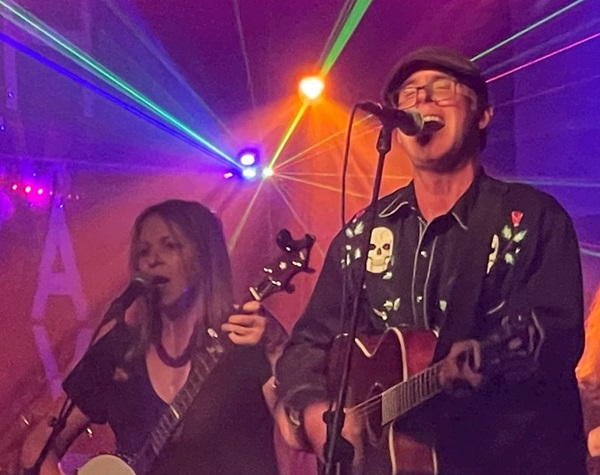
Andy, having been a prominent figure in the punk scene with Rat City Riot, the shift to blues, acoustic rock, and alternative country with The Smokeboss Militia is intriguing. What inspired this transition, and how has your punk background influenced the creation of the album Rise Again?
Well, I started writing songs very shortly after I joined my first band way back in high school. And as I learned to play guitar I figured out the best way to improve was to play with as many people from different musical places as possible. So I had toes in classic rock, blues, folk, Irish, and then punk as I met more musicians. Genre was never the be-all end-all for me, as great songs came from everywhere. So as I branched out I was influenced by a wide range of music and artists. But the spirit of punk has always been with me and I think you can hear that among the many influences that come together for Rise Again. But the punk ideal of doing it differently with an emotional shake-up is always there when I write, even if the music itself doesn’t sound punk. I think the way forward always incorporates experimentation.
There are lots of talented musicians involved in this project. How did this 13-piece come together?
I’ve been so lucky to meet and play music with so many of my heroes over the years, and luckier still when it came time to make the record that so many of them were willing and available to throw down on the tracks. I’ve known Peter Levin for many many years, and still thank my lucky stars that he laid down some of his keyboard mastery on this record. He is a reigning deity among the Jam band set. And then there’s Roger Rivas who’s reggae keyboards are world renowned. I met Roger during the RCR years and am always floored by his skill. Then you have Ritchie Orduno who is my favorite lead guitar player- nobody plays with such a personal style and voice intertwined with fretboard proficiency. John Ace is a remarkable fiddle player I met more recently and is unmatched as well. Tie it all together with a drummer like Bill Meredith- also a more recent addition- and you’ve really got you’re project running right.
A lot of the musicians on this record are doing their own thing in other geographical places so they recorded to tracks we sent them. Lucia Hare-Leahy’s banjo and vocals just naturally entwined with my music stylings and were both glue and sparkle that made the sound unique. Guy Gualtieri, our expert engineer, really made it all sound the best it could and made the whole process an amazing experience. But yeah, mostly just good fortune. Everyone forged an understanding with it and brought their best to it and that’s why it worked out so well.
You mentioned that the album is a collection of songs written over many years. How do you approach the creative process and songwriting for a project that covers a wide range of genres and styles?
I like to let the music and lyrics tell me what they are, as opposed to shoving them where I want them. For example, when I started writing Misunderstood- born from the line: “I am not misunderstanding I am just misunderstood”- I originally hear it as an R&B song. Songs become their true selves as you flesh them out, but you have to trust them enough to follow the signs. So what started with more of an Otis Redding-y vibe came into its own when we added a more bluegrass-y feel. It’s all about trying to help it find its true self rather than just forcing it according to your own wishes.
What’s your favorite venue to perform at?
I love performing anywhere there’s an audience but I’ve found as I get older I really like being outside on a bigger stage. I’ve had some of the greatest shows of my time in dives with no stages as well as concert halls with thousands of people. It always comes down to how good the band’s musical performance is mixing with the crowd’s enthusiasm.
Do you have a specific process or ritual when creating new music?
There are several I have tried but none work all the time. It seems the most important thing is to write down or record an idea. And then give it a little time to gestate on its own. The best songs I’ve ever done are the ones I let happen rather than made happen. The second part is balancing keeping after it while allowing it to shape itself. It’s tricky.
Any favorite artists or albums you’re listening to at the moment?
Peter Levin’s new record is great. Been listening to the Jayhawks, Hot Rize, Stevie Wonder, Tom Waits, the Bad Brains, the list goes on and all over the place…
If you could collaborate with any artist, alive or dead, who would it be?
I would still love to hear Otis Redding sing Misunderstood. Or a power trio with Prince and Dave Grohl would be cool but I would have to really practice my bass.
What do you find is the most satisfying part of being an artist?
When you get a song just write in the writing and recording process and somebody gets what you meant. When an artist you respect gives you respect back. When you leave a stage knowing you have nothing left, that you left everything you had up there. Those are the satisfying parts.
What is the biggest challenge you find in today’s music industry?
Cutting through the noise that the industry generates.
What’s upcoming for the project?
We’re putting together a touring band in the hopes of taking these songs as far and wide as we can. Time to put music on the streets of the world again!





